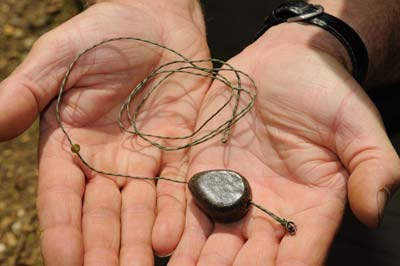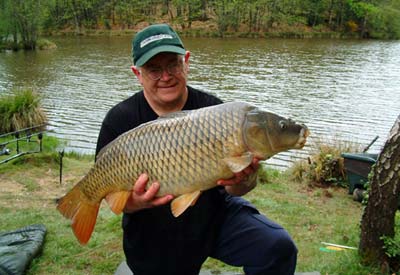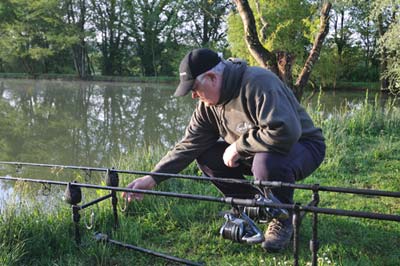I think there are many times in fishing when someone devises a method that enjoys a great deal of success, but not for the reason the method was devised in the first place. Take the modern version of slack line fishing, very ably described in Ken Townley’s excellent article in Coarse Fisherman magazine.
The principle of the modern concept of slack line fishing, or at least how Ken describes it, is that you use a very heavy running weight (5 – 6oz) on the terminal tackle, use a dense line that will sink to the bottom, allow plenty of slack so that it can do so, and then help to pin it there with the aid of a length of leadcore line at the terminal end and a backlead closer to the rod end. The idea is to make sure the weight is heavy enough not to move when the fish runs with the bait, so that the line runs freely through the ring on the pendant weight or through the hole in the inline weight.
 |
| There’s no way this lead core will run through the lead on the take |
My first thought was, what are we trying to achieve with the slack line method?
Ken wrote, “The bolt rig, then the hair rig – and the use of heavy leads for a time – created blistering runs but as the carp began to wise up so standard tactics began to lose their effectiveness. Slack line fishing may possibly be the answer to your prayers if you are suffering dropped or stuttery non-productive takes.”
Which led me to ask: what does slack line fishing offer that tight line fishing doesn’t? And the only conclusion I can arrive at is that slack line fishing gets the line down on the bottom, away from the attentions of the fish. Other than that I can see no difference. Let’s look at the main features of slack line fishing and compare them to ‘standard’ bolt-rigging.
A very heavy lead is recommended because a lighter one would pull out of position and therefore the line wouldn’t be running through it, but dragging it, albeit intermittently, as it bumped along the lake bed, through weed, etc. What I’m tempted to ask is: so what? On the initial pickup, whatever the set-up, providing a decent hook-up rig is being used, the fish is going to get pricked and then it’s going to bolt. If that doesn’t happen then all the misgivings about drop-backs and fishing to islands are justified. Once that fish is on the move and the angler has bent the rod into it, the lead, light or heavy, running or fixed, is going to be bumping along the bottom or suspended on a tight line, depending how far from the angler the fight is taking place.
When that fish first bolts at any angle other than directly away from the rod it’s going to move the lead, and even then it’s probably going to lift it off bottom, and especially when that first 1.5m of leadcore tries to run through an inline lead, and even more especially when any one of those three or four cracks in the lead core that Ken introduces try to run at an angle through the lead.
 |
| The fish can’t run directly away from you when casting to an island |
It would take a lead much heavier than an angler could cast with even stepped up carp gear for that lead to stay put on the initial take and allow the lead core to run. Once past the lead core and the suddenness of the initial bolt, then the mono main line may just run, if the angle isn’t too acute. But it doesn’t matter anyway, as you will by then have lifted the rod and will be playing the fish. Of course, what I’m suggesting really happens revolves around one major ingredient – water, and the fact that it is denser than air. If you try to imagine what I’m saying without that ingredient then my suggestion doesn’t work. To grasp the concept fully let’s say you’ve cast your 5 – 6oz lead to about 80yds to a swim about 6 – 8ft deep and then followed Ken’s advice by not tightening up, peeling off more line, and then allowing it all to sink tight to the bottom, aided by the flying back lead. Now, pick the rod up and try to get all that line up off the bottom, with most of it clear of the water with the rod held high – without moving the lead.
 |
| Wherever you set the indicators, the lead will still move on the take |
Can you do it? Maybe, just maybe, if the lead has bedded into silt to some extent, and especially if you take your time, lifting the rod very, very slowly.
Now do it fast, about as fast as a carp usually bolts off.
What happened? The lead moved. The line didn’t suddenly cut through the water and zip through the surface as you heaved the rod high. No, the line followed its own curve to a great extent and the lead followed it.
None of which means that Ken’s slack line method doesn’t work, just that it works for different reasons than the one suggested, the main one being that the line is way down on the bottom away from the attentions of the fish. Other than that it is still behaving like a fixed, or semi-fixed lead bolt rig.













